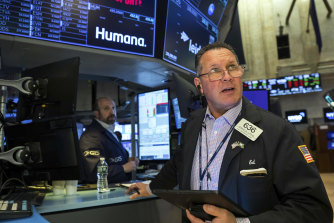ASX set to close out financial year with another loss
By Damian Troise, Alex Veiga and Angus Dalton
The Australian sharemarket is set to close the financial year with another losing session, with energy shares and the big four banks leading the way down.
The ASX 200 is 0.8 per cent lower at midday on Thursday, losing 55.1 points to 6645.1. Six out of 11 sectors, including materials, financials and utilities, are in the red. Energy led losses with a 1.5 per cent drop on the back of falling oil prices. The big four banks weighed on the index, all falling between 1.3 and 1.8 per cent.

The overall dip in the Australian sharemarket followed another choppy day of trading on Wall Street, as US Federal Reserve chairman Jay Powell signalled the window for wrestling inflation was closing and acknowledged there was a mounting risk of rates hikes pushing the US into a recession.
Trading in the US has been volatile all week amid growing signs the economy could be in for a recession under the pressure of stubbornly high inflation and sharply higher interest rates.
The S&P 500 ended 0.1 per cent lower after shifting between small gains and losses. The Dow Jones Industrial Average eked out a 0.3 per cent gain, while the Nasdaq composite slipped less than 0.1 per cent.
Investors snapped up US government bonds, sending yields lower. The yield on the 10-year Treasury, which influences rates on mortgages and other consumer loans, fell to 3.10 per cent from 3.20 per cent late Tuesday, a big move.
“Lower yields because we’ve got more economic risk is not a good thing for the market,” said Willie Delwiche, investment strategist at All Star Charts. “It’s on the bulls to prove that they can sustain some strength beyond a few days or a one-week rally.”
The S&P 500 slipped 2.72 points to 3,818.83. With one day left to go in June, the benchmark index is down 7.6 per cent for the month and down 20 per cent for the year.
The Dow rose 82.32 points to 31,029.31, while the Nasdaq dropped 3.65 points to 11,177.89.
The government reported that the economy shrank at a 1.6 per cent annual pace in the first three months of the year, its third and final estimate for GDP in the first three months of 2022. That figure was in line with previous estimates, and economists expect growth to resume later this year.
Investors have been closely watching economic data as they try to determine how deeply inflation is hurting consumers and businesses, while also keeping an eye on the Federal Reserve’s aggressive shift to raise interest rates.
The central bank is raising rates in an attempt to slow economic growth enough to temper inflation, but Wall Street is wary that the Fed could go too far and push the economy into a recession. Those concerns have been heightened by a series of reports showing a slowdown in retail sales and other indicators.
Consumers were held up as being resilient in the face of rising prices earlier this year, but that sentiment has faded, said Liz Ann Sonders, chief investment strategist at Charles Schwab. The latest GDP revision shows that consumer spending, which accounts for about two-thirds of economic output, was substantially weaker than the government had calculated earlier, growing at a 1.8 per cent annual pace instead of the 3.1 per cent it estimated in May.
“Not only is recession the base case, but I think it already may have begun,” Sonders said.
Fed Chair Jerome Powell, speaking Wednesday at a European Central Bank forum in Sintra, Portugal, repeated his hope that the Fed can achieve a so-called soft landing: raising interest rates just enough to slow the economy and rein in surging consumer prices without causing a recession and sharply raising the unemployment rate.
But, he said the path to achieving that goal has become more difficult and there’s “no guarantee” the central bank can tame runaway inflation without hurting the job market.
Lingering supply problems and a sharp jump in demand as the pandemic faded sparked a rise in inflation. It has grown worse through the year as supply chain problems worsened following new lockdowns in China to help control COVID-19 cases. Russia’s invasion of Ukraine in February sent energy prices higher and resulted in record high gasoline prices that have been eating away at consumers’ wallets.
Consumers have shifted spending from discretionary items like electronics to necessities as inflation grows hotter. A weaker-than-expected consumer confidence reading on Tuesday revealed that persistently high inflation was making Americans more pessimistic about both the present and future.
Energy stocks fell as the price of US crude oil dropped 1.8 per cent. Exxon Mobil slid 3.7 per cent.
Bed Bath & Beyond plunged 23.6 per cent after reporting a far bigger loss than analysts expected and replacing its CEO.
AP
The Market Recap newsletter is a wrap of the day’s trading. Get it each weekday afternoon.
Most Viewed in Business
Source: Thanks smh.com